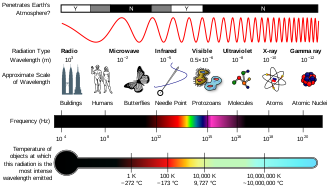Nanometre
| nanometre | |
|---|---|
SI | |
| Unit of | length |
| Symbol | nm |
| Conversions | |
| 1 nm in ... | ... is equal to ... |
| US units | 3.9370×10−8 in |

The nanometre (international spelling as used by the
picometres. One nanometre can be expressed in scientific notation
as 1×10−9 m, and as 1/1000000000 metres.
History
The nanometre was formerly known as the "millimicrometre" – or, more commonly, the "millimicron" for short – since it is 1/1000 of a micrometre, and was often denoted by the symbol mμ or, more rarely, as μμ (which is confusing, since μμ should logically refer to a millionth of a micron).[1][2][3]
Etymology
The name combines the
SI prefix nano- (from the Ancient Greek
νάνος, nanos, "dwarf") with the parent unit name metre (from Greek μέτρον, metrοn, "unit of measurement").
Usage
nanoscopic scale).[1]
The nanometre is often used to express dimensions on an atomic scale: the diameter of a
ångström
, which is equal to 0.1 nm, was formerly used for these purposes.
Since the late 1980s, in usages such as the
semiconductor node, it has also been used to describe typical feature sizes in successive generations of the ITRS Roadmap for miniaturized semiconductor device fabrication in the semiconductor industry
.
Unicode
The CJK Compatibility block in Unicode has the symbol U+339A ㎚ SQUARE NM.
References
- ^ .
- .
- ^ Terzaghi, Karl (1925). Erdbaumechanik auf bodenphysikalischer Grundlage. Vienna: Franz Deuticke. p. 32.
- ^ Hewakuruppu, Y., et al., Plasmonic " pump – probe " method to study semi-transparent nanofluids, Applied Optics, 52(24):6041-6050
External links
Look up nanometre in Wiktionary, the free dictionary.
